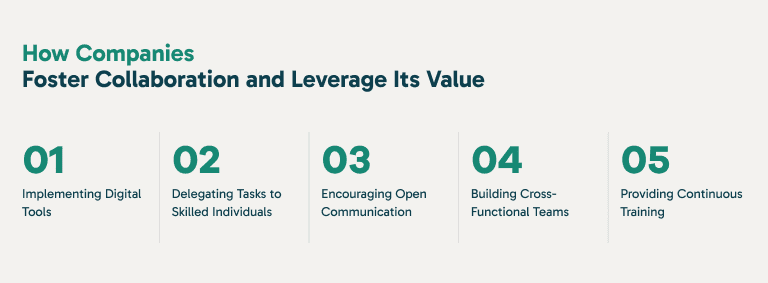project management · Jan 10, 2025
The Value of Collaboration that Every Company Should Know

Collaboration stands as one of the most pivotal core values for businesses striving to achieve sustainable growth and success. It transcends simple teamwork by fostering an environment where ideas are exchanged freely, talents are maximized, and innovation thrives.
In today's fast-paced corporate world, effective collaboration is no longer just a desirable trait—it’s a fundamental necessity for organizations of all sizes. This article delves into the undeniable value of collaboration, explores how companies can nurture it, and highlights how Quire can be a game-changer in unlocking its full potential.
The Value of Collaboration
Collaboration is more than just a buzzword; it’s the backbone of successful organizations. Here are some key ways collaboration adds value to businesses:
1. Ensuring Smooth Workflow
Collaboration streamlines processes by enabling teams to work together seamlessly. When team members communicate effectively and share responsibilities, they avoid bottlenecks and reduce redundancies.
For instance, in a product development cycle, marketing, design, and engineering teams must collaborate to align their goals, ensuring that the end product meets customer expectations on time.
2. Improved Creativity and Innovation
Innovation flourishes in collaborative environments where diverse perspectives converge. When individuals share their unique insights, the resulting synergy often leads to groundbreaking ideas.
Companies like Pixar attribute much of their creative success to a culture of open collaboration, where every idea is valued and explored.
3. Stronger Relationships and Trust
Effective collaboration builds stronger interpersonal relationships and trust among team members. Trust is essential for open communication, reducing conflicts, and fostering a positive work atmosphere.
Consider Google’s use of cross-functional teams, which encourages employees to build trust through shared goals and mutual respect.
4. Enhanced Problem-Solving Capabilities
Collaboration allows teams to pool their collective knowledge and skills to tackle challenges effectively. Diverse viewpoints contribute to more comprehensive problem-solving strategies.
For example, during a crisis, companies with collaborative cultures can pivot quickly because their teams are accustomed to working together under pressure.
5. Increased Employee Engagement
When employees feel their contributions are valued, they become more engaged and motivated. Collaborative workplaces empower team members to voice their opinions and play an active role in decision-making. This sense of inclusion boosts morale and productivity.
How Companies Foster Collaboration and Leverage Its Value

To unlock the full potential of collaboration, companies need to create a culture that actively promotes teamwork. Here are five effective strategies to foster collaboration:
1. Implementing Digital Tools
Modern collaboration relies heavily on digital tools that facilitate communication and task management. Tools like Quire provide platforms for real-time collaboration, enabling teams to track progress, share updates, and manage projects efficiently.
For example, remote teams can use Quire’s two-way sync with Google Calendar to align schedules seamlessly, ensuring everyone stays on the same page.
2. Delegating Tasks to Skilled Individuals
Delegation is a cornerstone of effective collaboration. Assigning tasks based on individual strengths ensures higher quality outcomes.
Companies like Amazon utilize data-driven strategies to match employees’ skills with specific tasks, maximizing productivity and fostering collaboration.
3. Encouraging Open Communication
An open communication culture is essential for collaboration. Companies should establish channels where employees feel safe sharing ideas and feedback. Weekly team meetings, anonymous suggestion platforms, and transparent leadership practices can make a significant difference.
For instance, Microsoft’s open-door policy encourages employees at all levels to share their thoughts freely.
4. Building Cross-Functional Teams
Cross-functional teams bring together individuals from different departments to work on shared objectives. This approach encourages the exchange of diverse ideas and strengthens interdepartmental relationships.
A great example is Spotify’s ‘squads’ model, where small, autonomous teams collaborate on specific projects.
5. Providing Continuous Training
Equipping employees with collaboration skills through training programs is vital. Workshops on active listening, conflict resolution, and team-building exercises help employees work better together. IBM, for example, invests heavily in training programs that focus on enhancing teamwork and collaborative skills.
Quire Helps Companies Unlock the Value of Collaboration
Quire stands out as a powerful project management software for fostering collaboration in organizations. Here’s how we helps companies maximize the benefits of teamwork:
1. Seamless Task Management
Quire’s intuitive interface allows teams to break down complex projects into manageable tasks. With features like nested task lists, employees can visualize dependencies and prioritize effectively, ensuring a smoother workflow.
2. Real-Time Updates and Transparency
Collaboration thrives on transparency, and Quire ensures everyone stays informed with real-time updates. Whether it’s a change in task deadlines or progress reports, team members can access all the information they need in one place.
3. Integration with Popular Tools
Quire integrates seamlessly with tools like Google Drive, Slack, and Outlook, making it easier for teams to collaborate without switching between platforms. These integrations simplify file sharing, communication, and scheduling, enhancing overall efficiency.
4. Promoting Accountability
By assigning clear responsibilities within tasks, Quire ensures accountability among team members. The platform’s notification system keeps everyone on track, reducing delays and misunderstandings.
5. Scalability for Growing Teams
As companies grow, their collaboration needs evolve. Quire’s flexible design scales effortlessly, accommodating larger teams and more complex projects without compromising usability.
Conclusion
Collaboration is a critical value that no company can afford to overlook. It drives innovation, streamlines workflows, and builds stronger teams, ultimately contributing to a company’s long-term success.
By fostering a culture of collaboration and leveraging tools like Quire, organizations can unlock new levels of productivity and efficiency. Start your journey toward better collaboration today, and witness the transformative impact it can have on your business.

